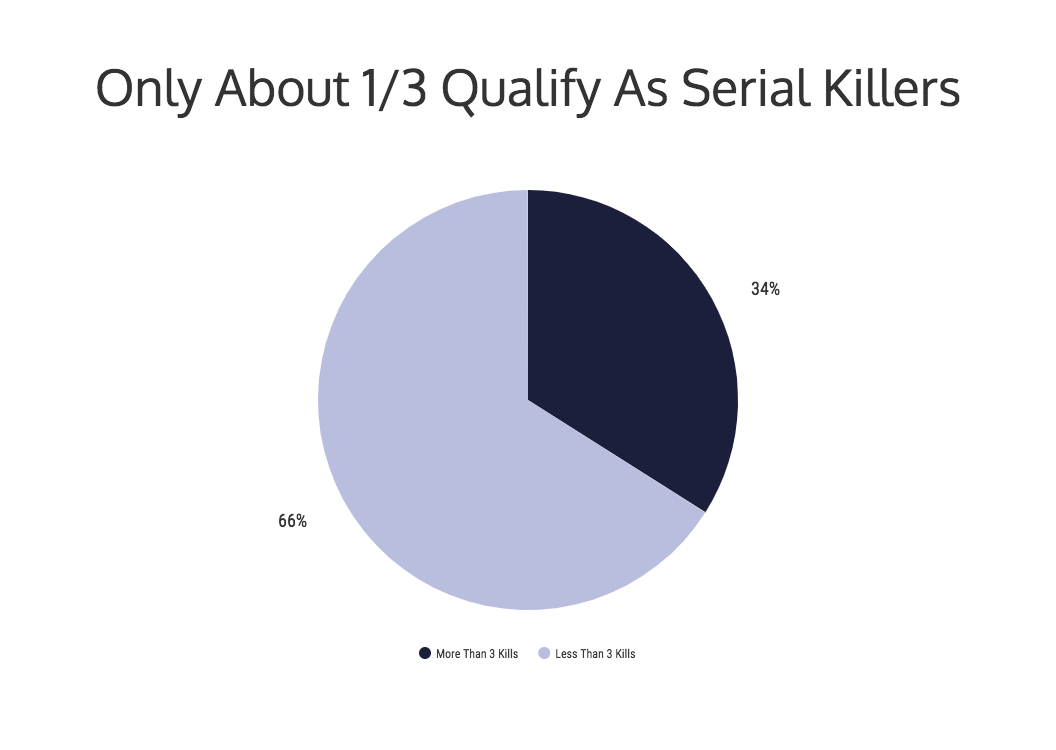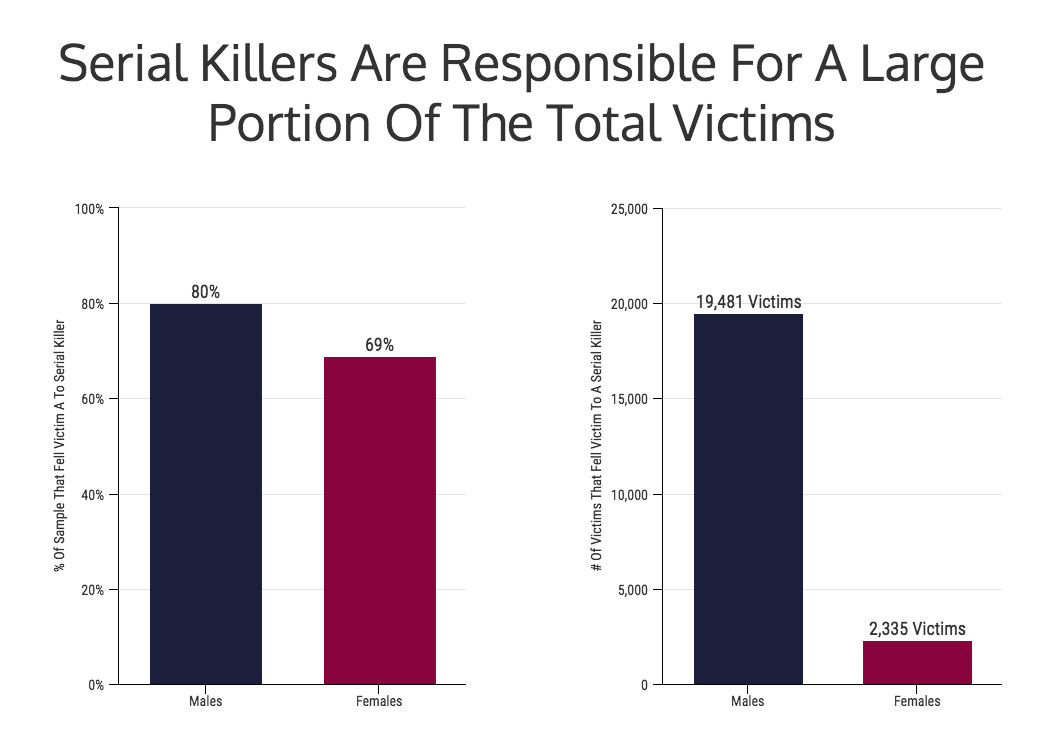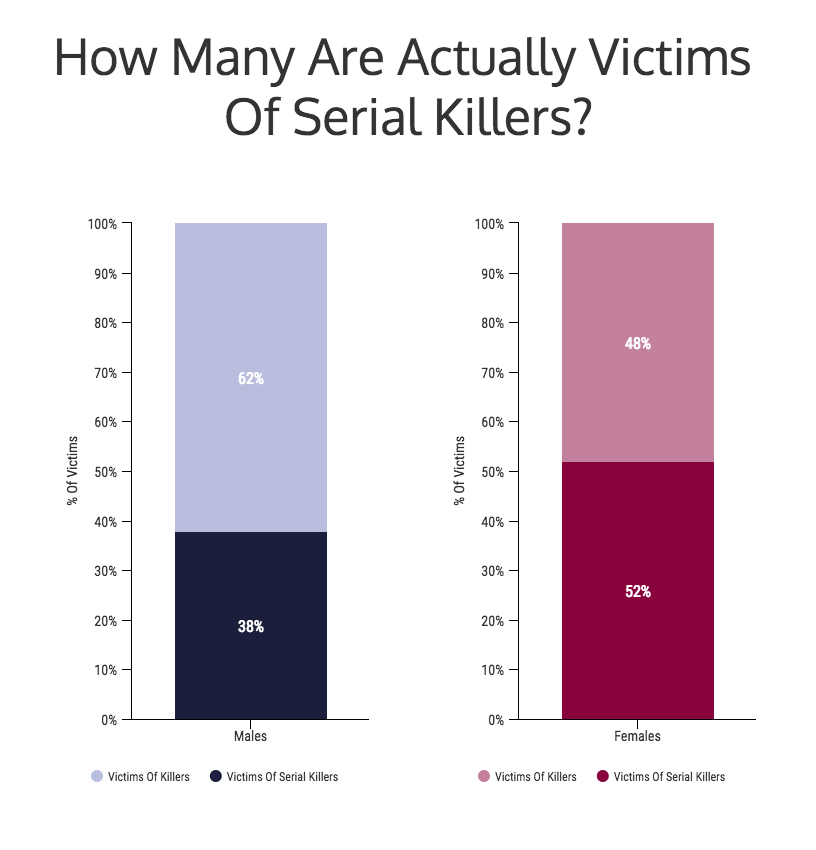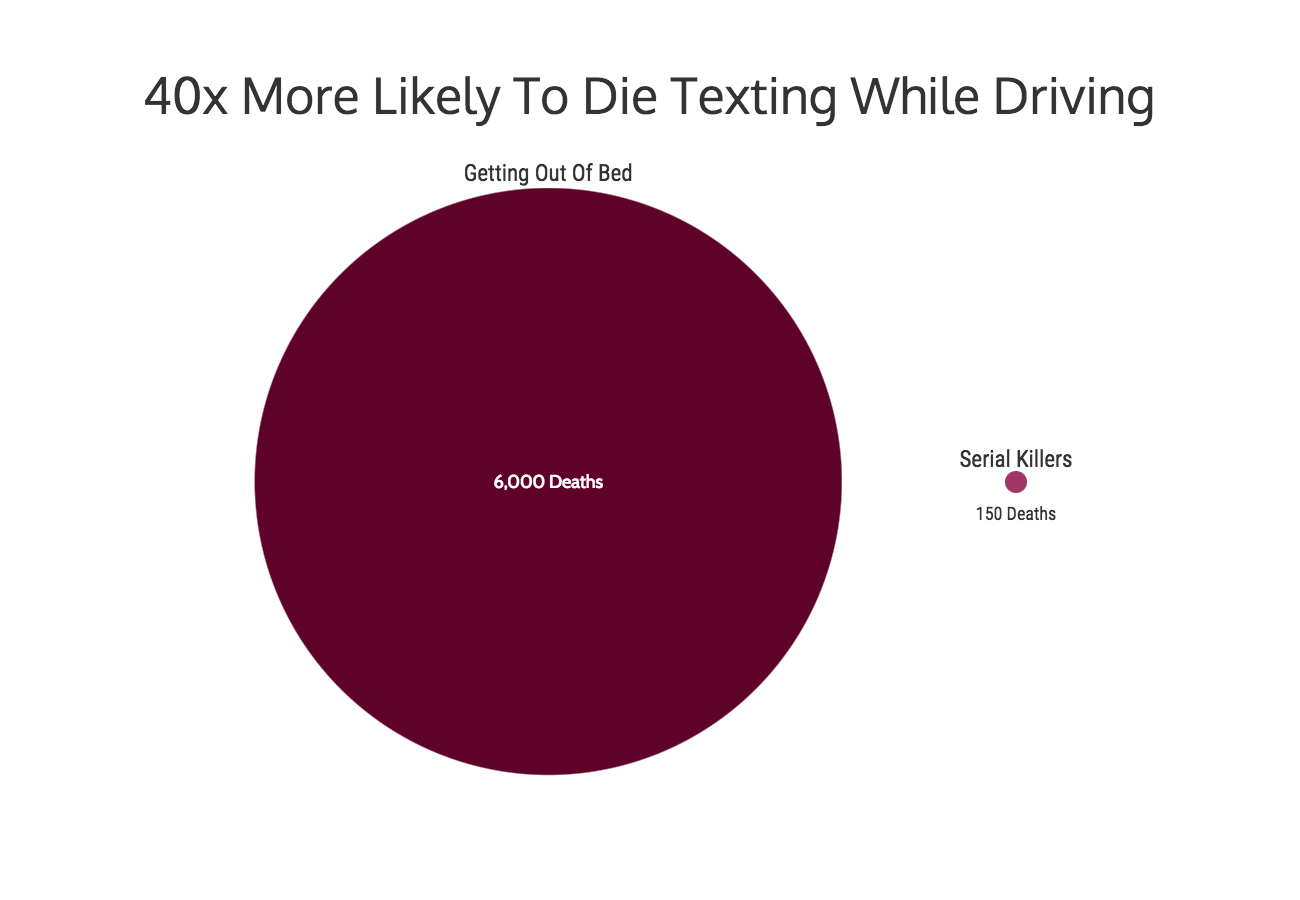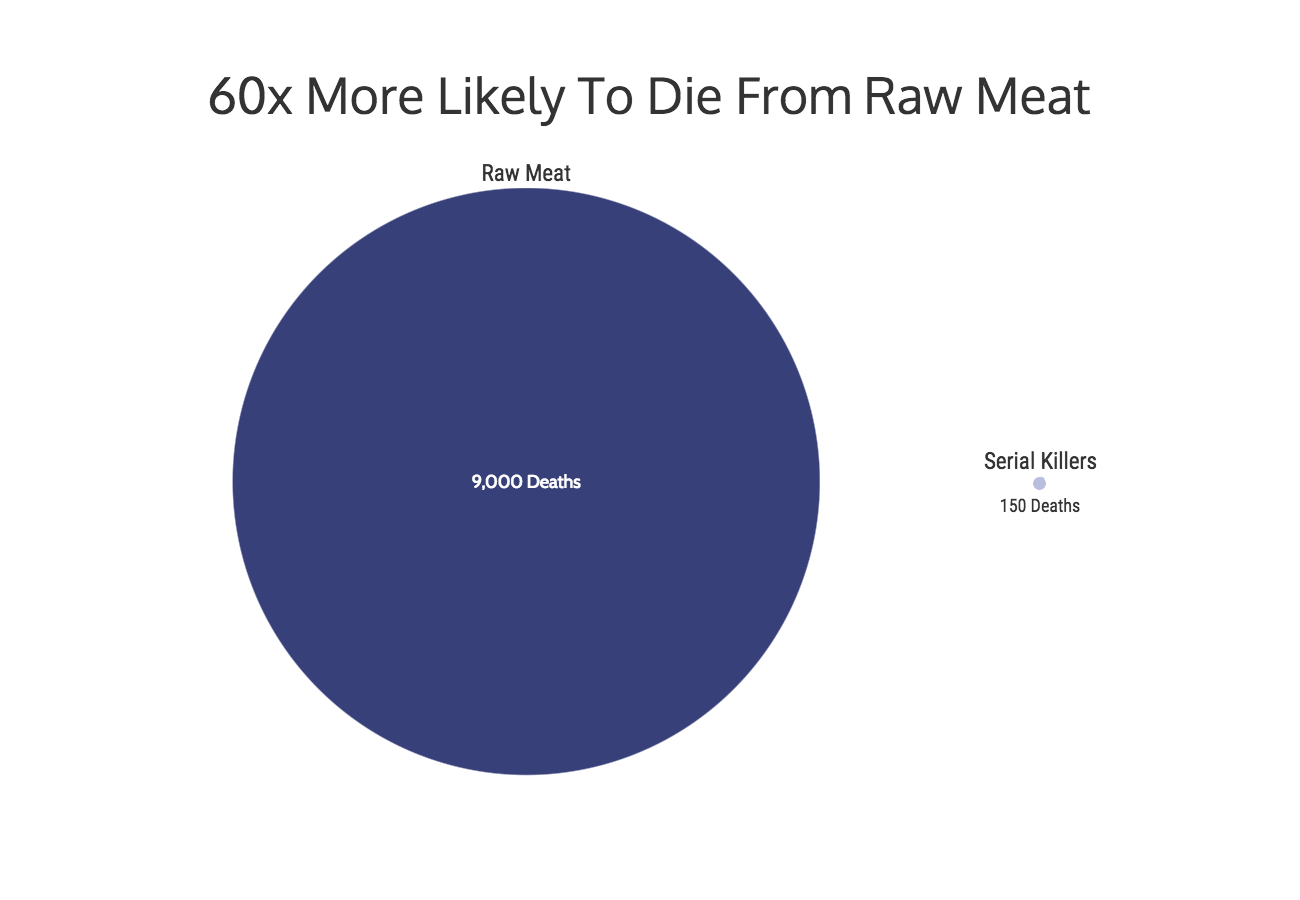Click the infographic to enlarge it.
After looking at this serial killers infographic, you are probably thinking that there is a serial killer lurking around every corner.
I don’t blame you for thinking that. But those people are the absolute worst of the worst this world has to offer.
With the media coverage of big cases and the endless shows that feature serial killers, it’s everywhere in our culture. And it doesn’t look like it’s going away, with the streaming giants bringing new crime shows to their platforms regularly.
I do admit that most of my favorite shows and podcasts deal with true crime. Some people may see that as dark or weird, but millions of people are just like me.
I have always been interested in serial killers and true crime because it was a way to deal with my own anxiety about the world and the unknown. If I knew more about the cases, there was less to be scared of in my day to day life.
More information about something that we all fear is a good thing to have.
And experts agree.
Many experts say that people love true crime because it allows us to deal with that fear in a controlled environment. We can experience and work through some of the fear in the comfort of our favorite chair.
So that is exactly what I am going to do: break those murders down in a controlled way and let all the data do the talking.
Then you will clearly see that serial killers should be at the bottom of your list of concerns.
Click the infographic to enlarge it.
Killers by the numbers
In the robust data set I collected information from over 7k different serial, mass and famous killers in the past 200+ years.
Each of these data points included the minimum and maximum number of victims, and even the locations and dates of these crimes.
This data was collected from the Murderpedia site and if you would like to see the raw data set do not hesitate to check out their site.
It took a lot of elbow grease to make it usable but it was worth it!
Also, I really wanted to avoid glorifying the serial killers, so that’s why you why I don’t go into detail about any of their cases. Instead I will treat it like any other data driven article and report on what I find.
Hopefully these findings will help quell your fear about the nonexistent serial killer hiding around the corner.
What state has the most serial killers?
I am from one of the most boring states in the country, Kansas. But we still claim a few terrifying serial or mass killers within our borders. With such a low population, I think the chance that you will run into one in Kansas is pretty low.
And I was right: with Kansas ranked near the bottom of the list, with only 24 male serial or mass killers and zero female. That’s well under the average for each state of 30 and 2, respectively.
However, there were some states that were were way above that average for male killers like California, New York and Florida:
Those states have the most outright serial killers in our study, so you should probably avoid them, right?
However, when you look at the population differences between all the states, the picture becomes clearer.
For example, California has 6.5x more people than the average state and only 6.75x more serial killers. And most of the states follow the simple formula of more males equals more male serial killers.
Except for Texas, where they only have 4.5x more people but nearly 6x more male serial killers.
This trend is echoed when you look at the female serial killers:
As you can clearly see, the top states were about the same as the male serial killers. Although California looks overly dangerous, it’s just as safe as any other state when you look at the population to serial killer ratio that I mentioned previously.
The only top state that doesn’t really follow this ratio in the female serial killer sample is Texas. It has 4.5x the average population but nearly 10x more female serial killers.
There are a few other states that don’t follow the ratio, like Missouri, which is my current home state.
Yeah, that doesn’t make me feel great.
If you want to check your own state the ratio of population to serial killers of each states can be seen below. I used only the male killers to make it a little easier to visualize, take a look:
Obviously, a negative number is the best for all of these states. That means that when compared to population, the number of serial killers in that state is extremely low.
A score close to zero means that your state is perfectly average when adjusted for population, which is not too bad.
But the bigger those numbers get, the more dangerous it gets because there is more serial killers in those states than average.
How did your state stack up? Let me know in the comments if you were surprised.
I definitely was when I saw that Missouri had such a high score!
Which countries have the most serial killers?
After looking at all fifty states, I thought it would be interesting to look at some of the killers from outside the country.
In the graph below, you can see that most of the sample from both the men and women committed their crimes in the US.
About 75% of all male killers 70% of females were committing their crimes in the States. There also was about 150 other countries that made up our sample from both the male and female killers.
When I took a look at the breakdown of the victims per country, things took an interesting turn. They did not seem to match up at all!
Although the US had exactly 75% of all male killers in the sample, they were only responsible for 50% of the victims. And the female killers from the US followed suit, with exactly 40% of the total victims as well.
This basically means that most of the crimes committed abroad had large body counts compared to the ones here.
It’s important to remember that like with any news story from another country, we may only hear it if it’s truly horrific, and most times second or third hand. That means the victim count and details of the crimes may have been exaggerated or even ignored.
So you should keep that in mind when looking at the number of killers or victims in other countries.
That’s why I am not surprised that almost all of the countries with the most killers behind the United States speak English. News is much easier to get when it comes from a place that speaks your same language.
While the countries with the most killers were mostly English speaking countries, the ones with the most victims were not at all.
This is where you should take some of the total number of victims with a grain of salt. Especially in places like China or Russia that tightly control their media companies.
And also keep in mind that in the past, places like Uganda and Guyana experienced civil war and genocide.
Honestly, because of that the numbers are probably higher than that but this is all the data we have access to right now.
And that is still a lot of killers and victims!
How many famous killers were men?
In this sample, there were 5,721 male killers, mostly from the 18th, 19th and 20th century.
The graph below looks at the lowest confirmed number of victims for all of those killers. I chose to look at that count because some of the counts of unconfirmed number of victim counts got a little out of hand.
According to some of the Murderpedia entries, a killer could have 1 or 100 victims.
That type of speculation was too much to deal with, so the minimum confirmed victims for each killer was used across the board.
These killers averaged about 5.393 victims across the board, but had a median of 2 victims.
The max victims clocked in at about 1000, and the minimum was, obviously, 1 person.
Because of the huge range of the sample, I think that the median of 2 victims told a more accurate story.
As you can see in the chart below, a majority of killers only have 1 to 2 victims across their lives, and mass killings are a rarity.
In fact, if you added up all the killers with more than 2 victims, it’s still less than those with under 2 victims.
Most do not even qualify as serial killers, with many being captured or killed after only 1 victim.
According to the FBI, a murderer must have 3 kills across a few months to officially qualify as a serial killer. This technicality brings down the chance that you will be killed by a serial killer pretty quickly…well, at least by a male serial killer.
How many famous killers were women?
After taking a dive into the male killers data set, I took a look at the women.
This data set was a lot smaller than the previous one, with only 1163 entries making the cut.
In this sample of female killers, the average came out to 2.97 victims per killer and the median was 1 victim.
Just like with the males data set, I think that the median told a more accurate story about the data we collected.
In the graph below, you can see that most of the female killers only had 1 victim:
I mean, having more than even 3 victims seems very unlikely in this situation. In fact, only about 19% of the entire sample even checks the first box of being a serial killer.
That means the likelihood of you meeting your maker from a female serial killer is pretty low. Most only have a single victim, similar to the male killers sample, but to an even greater extent.
Almost 60% of female killers only had 1 victim, and having more than 5 was almost unheard of–only 6% of the sample.
And if you tally up all the killers who had more than 1 victim, it’s still much less than those with only one.
So the idea that you are going to find a true serial killer in your backyard keeps becoming less believable the more we look at the data.
Are men more deadly than women?
Now that we have looked at both the datasets, it’s important to look at how they compare.
One of the first things that you will notice is that there were about 5 times more entries for men than women. But the male killers had almost 7x more victims, with an eye opening number of 24,196 people.
That was not even closely matched by the female killers, who had only 3,422 victims total.
So yes, I would say that the male killers are more violent than their female counterparts.
And as the chart below so eloquently show, males have almost double the victims. In fact, they average 85% more victims and the median is double when compared to female killers. That is a pretty big gap between the two groups, even when you take into account the bigger sample size.
The one thing that was common across both groups was that most of them would not be serial killers, with only 1 or 2 victims.
This, again, means that your chance of running into a serial killer is highly unlikely.
I know that this does not quell your fears completely but it does make me feel better.
Whenever I can put a number, percentage or ratio on the likelihood of something happening it always makes me feel in control.
How many of these murderers actually qualify as serial killers?
So if there were all those killers out there, how many actually qualified as serial killers?
As I mentioned earlier, a murderer must have more than 3 victims across multiple months or years to be categorized as a serial killer.
Because the data on each of the killer’s total victims is more exact we are going to look at that first.
Total Victim Count
Out of nearly all 7000 entries that I studied, only 34% of those murderers would qualify as serial killers.
Obviously, there was a lot more potential male serial killers, outpacing the females by a count of 2153 to 232. About 45% of all male killers in this sample could be called a serial killer if they meet the other checkbox of having a cooling off period between kills.
But only 19% of the the female killers check the victim count criteria.
That also means that there were almost 10x more potential male serial killers than females.
When you take into consideration that the men’s sample was only 5x bigger than the women, that gap looks pretty bad. And when you take a look at the victim count of the potential male serial killers, it looks even worse.
About 19k people in this sample were victims to a potential male serial or mass killer. On the other hand only 2.3k fell victim to a female perpetrator.
The breakdown of the total victims of a likely serial killer paints a morose picture to say the least.
Nearly 81% of all the total victims came from those 2,153 male serial killers and 69% from the 232 female killers, respectively.
So although there may be more one-off killers than serial killers, serial killers still account for a larger group of victims.
But as you will see in the next few sections, your chance of meeting a serial killer is almost nonexistent.
Time period of murders
The time periods given in this data set are less than exact. A lot of the entries used exact dates to denote the kills, but some used time ranges and that threw some of the counts off. So I am going to present the data and let you make your own assumptions.
Some could be mass killer and others could be serial killers but the time period data is not exact enough to be sure. Mass killers are those who kill all of their victims at once and serial killers have a cooling off period between kills.
That said, we found that a majority of the killers operated in a time period of less than a year. In fact, 78% of males and 84% of all female killers in this sample being active less than a year.
Now, that doesn’t automatically knock them off the list of serial killers, but it could.
The other killers that had more than one year between murders definitely could be serial killers, depending on the number of victims.
This trend is seen in both groups of data as you can see in the chart above. With a majority being active for less than one year, no matter the group.
Those are the ones that we are not going to really care about in the next section, because they can’t officially be branded a serial killer.
Instead, the ones that have been active for more than a year and with multiple victims is what we are going to look for.
The final count
After going through all that data, I am guessing that you are wondering how many we can call true serial killers. I can’t give you the exact number, because of the way the data was structured, but I can give a great estimate.
It should also be noted that these killers can either be serial or mass killers as well. It is not a definite count, but more an educated estimate based on the data I had access to.
This estimate is calculated using the total victim count of more than 3 victims and an active period of more than one year.
Based on all of my calculations, I would say there is at a minimum of 918 male and 128 female serial killers in this sample.
That means about 15% of the male killers in the sample are serial killers and around 11% of the women. That means that there are at the minimum 5x more killers than serial killers in this data set.
Like I said, this is a minimum count based on the most concrete data I could find on each of these killers.
These killers are responsible for almost exactly 12k victims across the centuries. With the male serial or mass killers claiming at the least 9160 victims and females clocking in at 1798 victims.
That makes up nearly 38% of all the victims that we analyzed for the male killers but about 52% of all the female killers.
The maximum estimate, which just eliminates those with less than 3 kills, is obviously going to be much higher. If we were to use that estimate, the count for males would double to 2152 serial killers and the count for female killers would increase twofold, to 232.
And if we look at the total victims for these potential serial killers that also almost doubles to around 21k victims.
Overall, out of all the famous killers that we have on this list, not many are truly serial killers.
They are instead just terrible people but your chance of running into either of one them is still extremely low.
Raw meat is more likely to kill you than a serial killer
It’s time to put the final nail in the coffin. Metaphorically.
I will show you how incredibly unlikely it is that you will meet your fate at the hands of a serial killer.
No matter how many movies and shows portray a serial killer hiding around every corner, there are much more dangerous things in your life.
For example, in just one year more people fall victim to heart disease by a factor 23x then we have in this sample…which stretches 200 years.
In fact, Scientific American that says about 150 people are killed by a serial killer each year.
That means that you are 4225x more likely to die from heart disease than at the hands of a serial killer. The difference between the two is so astronomically large, you can’t even see the serial killer dot without a microscope!
But there are some other weird ways that you are more likely to meet your maker than at the hands of a mass or serial killer…
Hopefully this smashes your fear of death by serial killer into a million little pieces!
First on the list, we have something that you do every day: get out of bed. And there are 450 reported deaths each year from that in the US.
Next, we have one thing that everyone does but no one likes to admit: texting and driving. That is the cause of death for nearly 6,000 people for year.
And finally, a death from something many people eat every day (well most days): meat. There are about 9,000 deaths per year from harmful things found in raw meat.
These are all things that you do each day and they are more likely to kill you than a serial killer.
Just remember that and you will be fine.
Conclusion
So if you think there is a killer hiding behind every bush I hope I helped quell that fear.
I mean, there are a million other things out there that you should be scared of.
Like global warming.
Or bears.
Because now that I know how unlikely it’s that you will die from a serial or mass killer using cold hard data, I feel a lot better already.
Thanks, math! You never let me down.
Want to create your own mind map? Here is a template you can use right now:

Click the infographic to enlarge it.















































